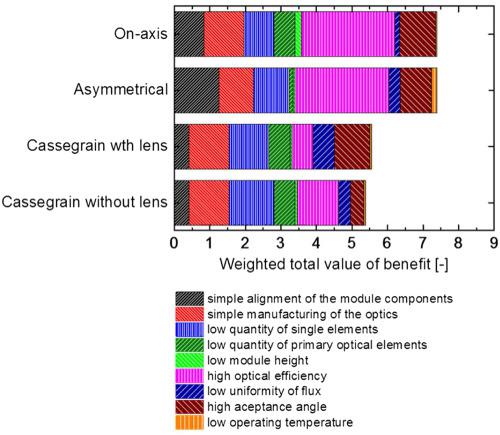当前位置:
X-MOL 学术
›
Prog. Photovoltaics
›
论文详情
Our official English website, www.x-mol.net, welcomes your feedback! (Note: you will need to create a separate account there.)
Systematic design evaluation on the example of a concentrator photovoltaic module with mirror optics and passive heat dissipation
Progress in Photovoltaics ( IF 6.7 ) Pub Date : 2018-04-10 , DOI: 10.1002/pip.3005 Maike Wiesenfarth 1 , Sebastian Gamisch 1 , Peter Jakob 1 , Marc Steiner 1 , Andreas W. Bett 1
Progress in Photovoltaics ( IF 6.7 ) Pub Date : 2018-04-10 , DOI: 10.1002/pip.3005 Maike Wiesenfarth 1 , Sebastian Gamisch 1 , Peter Jakob 1 , Marc Steiner 1 , Andreas W. Bett 1
Affiliation

|
In the design of concentrator photovoltaic modules, numerous components need to be optimised to achieve the highest performance of the complete system while simultaneously maintaining low costs for the manufacturing processes. In this paper, we present a systematic analysis of different designs of concentrator photovoltaic modules using mirror optics to concentrate the solar radiation by a factor of 1000 with passive heat dissipation. Module designs based on 4 different arrangements for the optics are investigated: on‐axis, asymmetrical, and Cassegrain with and without tertiary optics. Each design is optimised for high thermal, optical, and electrical performance via finite element method, ray tracing, and network simulations. Concepts for manufacturing are also proposed. The 4 specific designs are evaluated and compared in a systematic benefit analysis. In this analysis, 9 criteria are defined to describe the module performance and manufacturability. To quantify the benefit of each module design, utility values—a score to provide a value to the benefit—and weighting factors are defined. With this systematic analysis, the strengths and potential for optimisation are identified, and the different designs are compared. In addition, the potential for improvement is discussed surveying the different criteria.
中文翻译:

以带镜光学和无源散热的聚光光伏模块为例的系统设计评估
在集中器光伏模块的设计中,需要优化众多组件,以实现整个系统的最高性能,同时保持制造过程的低成本。在本文中,我们对聚光光伏模块的不同设计进行了系统分析,这些聚光光伏模块使用镜面光学器件以无源散热的方式将太阳辐射聚光了1000倍。研究了基于4种不同光学器件排列的模块设计:同轴,不对称和带和不带第三级光学器件的卡塞格林。通过有限元方法,光线追踪和网络仿真,每种设计都针对高热,光学和电气性能进行了优化。还提出了制造概念。在系统的收益分析中评估和比较了这4种具体设计。在此分析中,定义了9条标准来描述模块的性能和可制造性。为了量化每个模块设计的收益,定义了效用值(为收益提供价值的得分)和权重因子。通过这种系统的分析,可以确定优化的优势和潜力,并对不同的设计进行比较。此外,还讨论了改善不同标准的潜力。确定优化的优势和潜力,并比较不同的设计。此外,还将探讨不同的标准,以探讨改进的潜力。确定优化的优势和潜力,并比较不同的设计。此外,还将探讨不同的标准,以探讨改进的潜力。
更新日期:2018-04-10
中文翻译:

以带镜光学和无源散热的聚光光伏模块为例的系统设计评估
在集中器光伏模块的设计中,需要优化众多组件,以实现整个系统的最高性能,同时保持制造过程的低成本。在本文中,我们对聚光光伏模块的不同设计进行了系统分析,这些聚光光伏模块使用镜面光学器件以无源散热的方式将太阳辐射聚光了1000倍。研究了基于4种不同光学器件排列的模块设计:同轴,不对称和带和不带第三级光学器件的卡塞格林。通过有限元方法,光线追踪和网络仿真,每种设计都针对高热,光学和电气性能进行了优化。还提出了制造概念。在系统的收益分析中评估和比较了这4种具体设计。在此分析中,定义了9条标准来描述模块的性能和可制造性。为了量化每个模块设计的收益,定义了效用值(为收益提供价值的得分)和权重因子。通过这种系统的分析,可以确定优化的优势和潜力,并对不同的设计进行比较。此外,还讨论了改善不同标准的潜力。确定优化的优势和潜力,并比较不同的设计。此外,还将探讨不同的标准,以探讨改进的潜力。确定优化的优势和潜力,并比较不同的设计。此外,还将探讨不同的标准,以探讨改进的潜力。



























 京公网安备 11010802027423号
京公网安备 11010802027423号